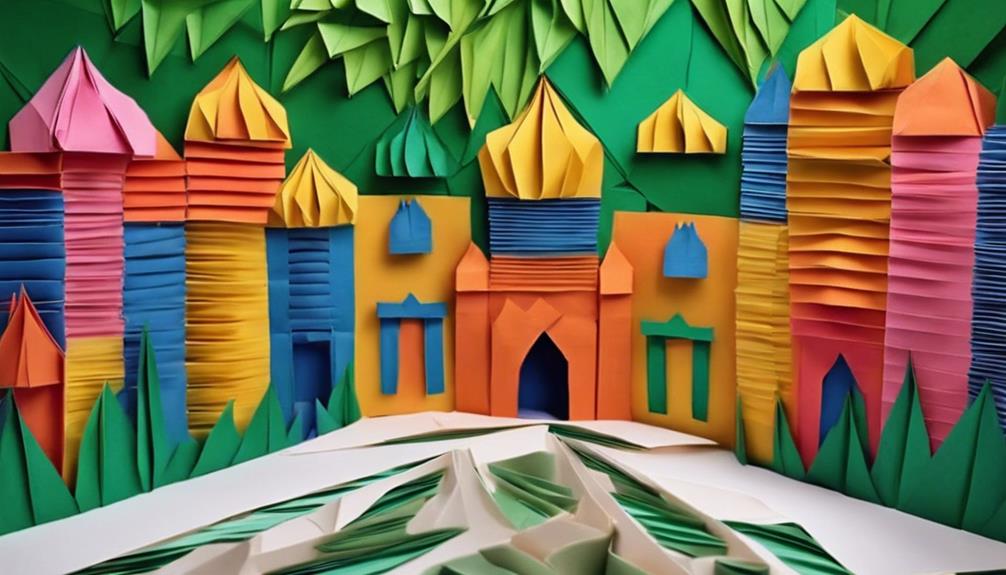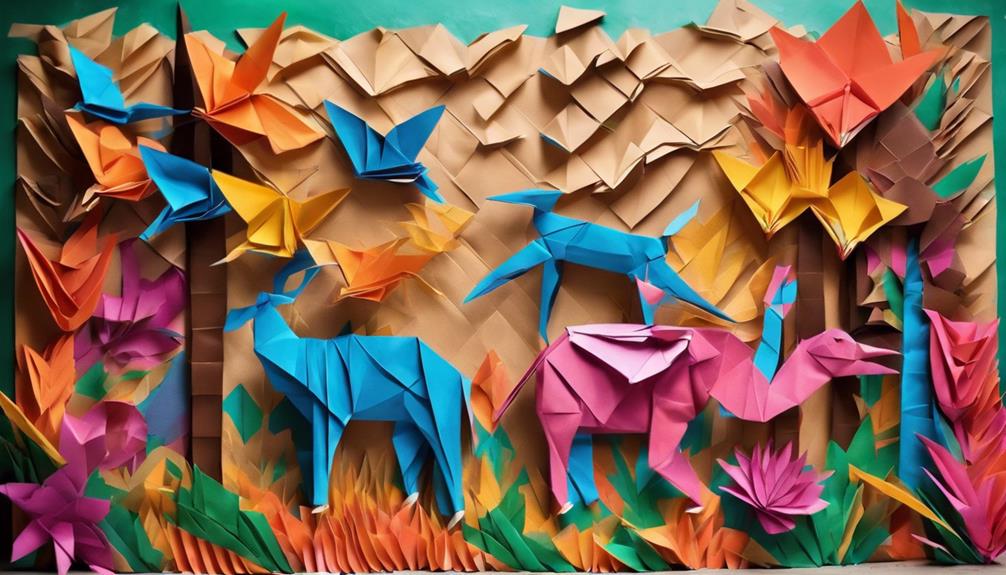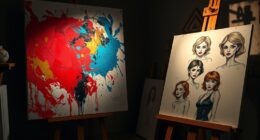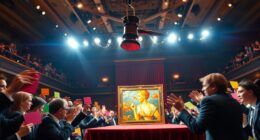Explore the ancient art trail of Madhya Pradesh, home to enchanting rock art sites like Bhimbetka, Chaturbhuj Nala, Pachmarhi Hill, and Adamgarh Rock Shelters. These sites showcase civilizations dating back over 10,000 years, offering a window into prehistoric art and culture. Discover the rich tapestry of beliefs and traditions preserved in these mystical landscapes. Efforts to protect and preserve these treasures are essential for decoding their cultural significance. Uncover the fascinating world of ancient civilizations through the lens of their art, providing insights into the historical journey of central India. Further insights into this hidden gem await discovery.
Key Takeaways
- Explore ancient rock art sites like Bhimbetka and Chaturbhuj Nala.
- Discover the rich cultural significance of prehistoric paintings in Madhya Pradesh.
- Immerse in the mystical landscapes and ancient civilizations of the region.
- Witness the intricate bead making art of the Baiga tribe.
- Indulge in a luxurious glamping experience in historical Mandu.
Rich Tapestry of Ancient Art
Within Madhya Pradesh, a rich tapestry of ancient art unfolds through its numerous rock art sites. These sites, such as Bhimbetka, Chaturbhuj Nala, Pachmarhi Hill, and Adamgarh Rock Shelters, offer a glimpse into the artistic expressions of ancient civilizations that once thrived in the region.
Bhimbetka, with over 700 rock shelters, boasts art dating back over 10,000 years, showcasing the enduring legacy of early human creativity. Chaturbhuj Nala's ancient rock paintings, spanning from 6,000 to 12,000 years old, provide valuable insights into the cultural practices of prehistoric societies.
Pachmarhi Hill's rock art, characterized by a diverse and intricate narrative, offers a window into the daily lives and beliefs of ancient inhabitants. Similarly, Adamgarh Rock Shelters exhibit detailed paintings that shed light on the artistic sophistication and societal structures of bygone civilizations.
These rock art sites in Madhya Pradesh serve as invaluable repositories of history, connecting us with the rich cultural heritage of the past.
Captivating Rock Art Sites

Exploring Madhya Pradesh's fascinating rock art sites reveals a glimpse into the ancient civilizations that once flourished in the region. These sites, including Bhimbetka, Chaturbhuj Nala, Pachmarhi Hill, and Adamgarh Rock Shelters, offer a window into prehistoric life and cultural practices of early societies. A brief overview of these intriguing rock art sites is provided in the table below:
| Rock Art Site | Historical Significance |
|---|---|
| Bhimbetka | Over 700 rock shelters with art dating back over 10,000 years, showcasing prehistoric life. |
| Chaturbhuj Nala | Ancient rock paintings ranging from 6,000 to 12,000 years old, capturing the artistic heritage of the region. |
| Pachmarhi Hill | Diverse and complex rock art providing insights into the social and cultural practices of prehistoric societies. |
| Adamgarh Rock Shelters | Intricate paintings offering a unique perspective on the ancient civilizations that once thrived in the region. |
These rock art sites stand as demonstrations to the rich history and cultural heritage of Madhya Pradesh, inviting visitors to discover the mysteries of our ancestors' past.
Prehistoric Paintings Dating Back Millennia

Prehistoric paintings found in Madhya Pradesh, such as those in Bhimbetka and Chaturbhuj Nala, date back millennia and offer valuable insights into ancient civilizations.
These ancient rock art discoveries not only hold immense cultural significance but also present challenges regarding preservation and conservation for future generations to appreciate.
The intricate details and symbolic representations in these prehistoric paintings provide a window into the past, shedding light on the rich history of the region.
Ancient Rock Art Discovery
Dating back millennia, the ancient rock art discovered in Madhya Pradesh offers a fascinating glimpse into prehistoric artistic expressions. Madhya Pradesh is home to renowned sites like Bhimbetka, containing over 700 rock shelters dating back over 10,000 years, and Chaturbhuj Nala, showcasing paintings from 6,000 to 12,000 years ago.
These ancient civilizations left behind a treasure trove of artistic expressions, providing insights into their daily lives and cultural practices. The intricate rock paintings found in places like Pachmarhi Hill and Adamgarh Rock Shelters depict a wide array of themes, ranging from spiritual rituals to wildlife encounters.
These millennia-old artworks not only highlight the creativity of ancient societies but also serve as a tribute to the rich cultural heritage of the region. The rock art sites in Madhya Pradesh stand as living reminders to the artistic prowess of our prehistoric ancestors, inviting us to explore further into the mysteries of the past.
Cultural Significance Decoded
The ancient rock paintings found in Madhya Pradesh's renowned sites like Bhimbetka and Chaturbhuj Nala reveal a rich cultural tapestry dating back over 10,000 years. These prehistoric artworks offer a glimpse into the daily lives, spiritual practices, and interactions with wildlife of the ancient inhabitants.
The rock art galleries in Madhya Pradesh serve as invaluable repositories of cultural significance, showcasing a diverse range of artwork that encapsulates the beliefs, traditions, and social structures of past civilizations. Paintings such as those at Ran Bhaisa Chittauri date back over 5000 years, with some even older, ranging from 8000 to 10000 years in antiquity.
The preservation of these delicate and intricate rock art wonders is paramount to safeguarding this rich cultural heritage for posterity. Therefore, efforts to protect these sites from damage and deterioration are essential to ensuring that future generations can continue to decode the cultural significance embedded within these ancient artworks.
Preservation Challenges Addressed
Efforts to safeguard the ancient rock paintings in Madhya Pradesh from damage and deterioration are paramount to preserving their cultural and historical significance.
These prehistoric artworks, dating back over millennia, hold invaluable insights into the region's past and are a proof of the creativity of early human civilizations.
Sites like Bhimbetka and Chaturbhuj Nala are repositories of ancient wisdom, offering a glimpse into the lives of our ancestors through vivid depictions on rocky canvases.
The delicate nature of these rock art pieces requires meticulous preservation techniques to guarantee their longevity for future generations to appreciate and study.
Discovery and Preservation of Ancient Art

Madhya Pradesh boasts a significant treasure trove of ancient art. The state is home to rock paintings scattered across the Satpura and Vindhyan ranges. These artworks, dating back millennia, offer invaluable insights into the cultural and historical evolution of early societies in the region.
Preservation initiatives are essential in safeguarding these artistic expressions. They ensure that these ancient artworks continue to enlighten and inspire future generations.
Artistic Heritage Preservation
Discovering the intricate rock art sites in Madhya Pradesh reveals a treasure trove of ancient paintings dating back thousands of years. The rock art found in Madhya Pradesh, such as at Bhimbetka and Chaturbhuj Nala, offers a window into the past, showcasing scenes of daily life, spiritual rituals, and encounters with wildlife.
Efforts to preserve this artistic heritage are essential in safeguarding these delicate rock paintings from weathering and human interference. Regions like the Satpura and Vindhyan ranges are renowned for their diverse rock art, shedding light on the beliefs, traditions, and social structures of ancient civilizations.
Galleries like Ran Bhaisa Chittauri contain paintings that are over 5000 years old, providing a valuable glimpse into the rich artistic history of the region. By focusing on conservation and protection, Madhya Pradesh ensures that these ancient artworks continue to serve as invaluable cultural and historical resources for generations to come.
Uncovering Ancient Art
Revealing the ancient art hidden within Madhya Pradesh's Satpura and Vindhyan ranges exposes a rich tapestry of cultural heritage dating back thousands of years. These regions are renowned for preserving ancient rock art that offers glimpses into the daily lives, rituals, and wildlife encounters of past civilizations.
Sites like Bhimbetka and Chaturbhuj Nala showcase diverse paintings, providing insights into the beliefs and traditions of ancient societies. The rock paintings, some over 5000 years old in galleries like Ran Bhaisa Chittauri, serve as valuable historical records of social structures and cultural practices in Madhya Pradesh.
Preservation efforts for these delicate artworks are essential to safeguard them from damage and ensure their historical significance endures. By protecting and studying these ancient rock art sites, Madhya Pradesh preserves an important link to its past, allowing current and future generations to appreciate and learn from the artistic expressions of their ancestors.
Uncovering Beliefs and Traditions

Exploring the rock art sites in Madhya Pradesh reveals a vivid tapestry of ancient beliefs and traditions passed down through millennia. Sites like Bhimbetka and Chaturbhuj Nala exhibit over 10,000-year-old paintings depicting daily life, spiritual rituals, and encounters with wildlife.
These artworks offer valuable insights into the cultural heritage of ancient societies that once thrived in the region. Preservation efforts in Madhya Pradesh guarantee that the diverse rock paintings accurately reflect the beliefs, traditions, and social structures of bygone eras.
Through intricate and well-preserved artwork, these sites provide a glimpse into the religious practices, mythological stories, and cultural practices of ancient civilizations that shaped the region.
Mystical Landscapes of Madhya Pradesh

Madhya Pradesh captivates visitors with its mystical landscapes, boasting ancient rock art sites like Bhimbetka, Chaturbhuj Nala, Pachmarhi Hill, and Adamgarh Rock Shelters. These rock art sites offer a glimpse into the ancient civilizations that once thrived in the region.
Bhimbetka, with over 700 rock shelters dating back over 10,000 years, stands as proof of the rich history of Madhya Pradesh. The rock paintings at Chaturbhuj Nala, estimated to be between 6,000 to 12,000 years old, provide valuable insights into prehistoric art and culture.
Pachmarhi Hill showcases a diverse array of complex rock art, shedding light on the societies of the past that inhabited the area. Additionally, the intricate paintings found at Adamgarh Rock Shelters offer a fascinating window into the ancient civilizations that once flourished in Madhya Pradesh.
These sites not only serve as archaeological treasures but also as reminders of the enduring legacy of the region's early inhabitants.
Glamping Under the Mandu Sky

The reveal of experiencing luxury camping under the starry Mandu sky in Madhya Pradesh beckons travelers seeking a unique blend of comfort and adventure.
Nestled in the heart of Madhya Pradesh, Mandu offers a picturesque backdrop for indulging in the historical and architectural marvels of the region while staying in opulent tents. This form of luxury camping not only provides a cozy retreat but also serves as a gateway to immerse oneself in the rich cultural exploration of central India.
By opting for this distinctive experience, adventurers can enjoy a harmonious mix of thrill and relaxation as they explore offbeat destinations in Madhya Pradesh. Explore the hidden gems of Mandu and Central India while partaking in this one-of-a-kind art trail, which promises to uncover the region's secrets and charm like never before.
Luxury camping in Mandu opens up a world of possibilities for those keen to explore the cultural tapestry of Madhya Pradesh in a novel and unforgettable manner.
Baiga Tribe's Bead Making Art

Known for their intricate bead making art, the Baiga tribe in Madhya Pradesh showcases traditional craftsmanship using natural materials like seeds, wood, and clay. Each bead, meticulously handcrafted by Baiga artisans, reflects the tribe's rich cultural heritage and artistic skills.
This bead making art not only serves as a form of self-expression but also as a medium for storytelling, capturing the essence of the Baiga tribe's identity and history.
Through the vibrant and unique beads created by the Baiga tribe, ancestral knowledge is passed down, traditions are preserved, and the tribe's legacy is celebrated. The significance of bead making in Baiga culture goes beyond mere adornment; it's a symbol of pride and a connection to their roots.
As visitors explore Madhya Pradesh, delving into the world of the Baiga tribe's bead making art offers a glimpse into a timeless tradition that continues to thrive amidst modernity.
Destinations for Quiet Reflection

For those seeking moments of peace and contemplation, several destinations in Madhya Pradesh offer tranquil settings for quiet reflection. The rock art sites of Bhimbetka, Chaturbhuj Nala, Pachmarhi Hill, and Adamgarh Rock Shelters provide serene environments where visitors can immerse themselves in ancient and prehistoric artwork.
Bhimbetka boasts over 700 rock shelters dating back over 10,000 years, offering a glimpse into ancient art and culture. Chaturbhuj Nala's rock paintings, ranging from 6,000 to 12,000 years old, depict scenes that provide insights into prehistoric societies.
The complex and diverse rock art at Pachmarhi Hill reflects the rich history and artistic expressions of early civilizations, while the intricate paintings at Adamgarh Rock Shelters offer further understanding of the ancient civilizations that once thrived in the region. These destinations not only provide a tranquil escape from the hustle and bustle but also serve as gateways to the past, inviting contemplation and reflection amidst the ancient wonders of Madhya Pradesh.
Frequently Asked Questions
What Is the Famous Art of Madhya Pradesh?
The famous art of Madhya Pradesh is its ancient rock art, found in sites like Bhimbetka, Chaturbhuj Nala, Pachmarhi Hill, and Adamgarh Rock Shelters. These rock paintings date back thousands of years and depict daily life, spiritual rituals, wildlife encounters, and insights into prehistoric societies.
Madhya Pradesh's rock art heritage reflects a rich history, cultural significance, and artistry, fascinating enthusiasts and scholars worldwide.
What Is Madhya Pradesh Famous For?
Madhya Pradesh, known as the 'Heart of India,' is famous for its ancient rock art sites like Bhimbetka, Chaturbhuj Nala, Pachmarhi Hill, and Adamgarh Rock Shelters. These sites preserve over 10,000-year-old art, offering insights into the rich cultural heritage and prehistoric societies of the region.
Beyond art, Madhya Pradesh boasts diverse wildlife, lush forests, historic temples, and architectural marvels, making it a must-visit destination for history and nature enthusiasts.
What Is the Tribal Craft in Madhya Pradesh?
Tribal craft in Madhya Pradesh encompasses a rich tapestry of artistic expressions. Gond art features intricate patterns and vibrant colors, while Bhil and Bhilala tribes showcase unique tribal paintings with intricate detailing.
The Bastar region is renowned for Dhokra art, a traditional metal casting technique. Additionally, various indigenous communities contribute to the state's tribal craft through weaving, pottery, and beadwork, preserving centuries-old traditions and cultural heritage.
What Is Famous in MP to Buy?
In Madhya Pradesh, visitors can purchase unique handicrafts like Chanderi and Maheshwari sarees, tribal jewelry, Gond paintings, terracotta figurines, and Bagh prints.
These traditional textiles are highly acclaimed, including handloom fabrics such as Chanderi, Maheshwari, and Bagh prints, offering a wide range of options for shoppers.
The state is renowned for its tribal art forms, especially Bhil and Gond paintings, reflecting the rich cultural heritage of the region.
Conclusion
To sum up, the ancient art trail of Madhya Pradesh offers a fascinating glimpse into the rich cultural heritage of India. With over 800 rock art sites and prehistoric paintings dating back millennia, visitors can immerse themselves in the mystical landscapes and traditions of this region.
One interesting statistic is that Madhya Pradesh is home to the highest number of rock art sites in India, making it a must-visit destination for art enthusiasts and history buffs alike.









